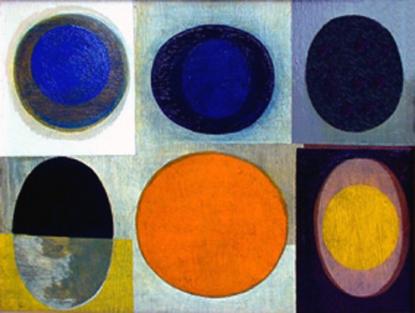2024. April 20. Saturday
The exhibition has closed for visitors.
2004.06.10. - 2004.07.04.
Born and living in Pécs, Ferenc Lantos has made himself a significant reputation on the 20th-century Hungarian art scene. Held on the artist's 75th birthday, this exhibition presents the first part of his oeuvre.

Ferenc Lantos's art might be labelled as Mediterranean. His starting point was nature, and following the inner logic of nature - and his master, Ferenc Martyn - he developed his nature- principled abstraction, a special balance between the rational and the organic approaches, setting a special course in 20th-century Hungarian art and making an exceptional contribution to European methodical thought.
This exhibition presents the beginning and growth of that harmony. It starts with a juvenile portfolio from 1948 which contains drawings in Indian ink. Some of them feature the rounded forms and interconnecting arcs which give a hint of the artist's wide-ranging sense of form and his painterly interest in creating a means of imagery for depicting the concatenations of natural phenomena. Other drawings take a different approach with the amorphous forms apparently in motion. He had by this time created his first abstract 'landscapes': shapeless forms painted on fibred damp paper. These drawings promoted his painterly means of imagery from a means to co-artist. Life and motion became united in the continuous interference of the circle and the square - a feature that went on to become Lantos's trademark.
This duality of his art was marked by his attendance of many artist colonies round the country (Mecseknádasd, Tokaj) and his workshop experiments in a whole range of different techniques (porcelain, enamel). Documents of the evolution of his art include Balaton landscapes from the 50s and 60s - that is landscape-reductions, abstractions of forms both natural (circles: sun, pebbles) and artificial (sailing boats) - as well as his more rigorous, constructive and relaxed compositions which, being watercolours, feature a purer and more intensive world of colours. Colours come in many shapes and forms: elusive colour-spots and vigorous colour-bands evolved into a characteristic Lantosian colour-idiom. Landscapes are reflected, or portrayed from above, making for an autonomous means of imagery. Systemizing his painterly knowledge of the world in the 70s, his books and exhibitions entitled Nature - Seeing - Art were presented at the Hungarian National Gallery in 1977. His discovery of the endless possibilities inherent in natural and artificial systems took the form of a series of paintings, some of which were exhibited at the Ernst Museum back in 1999.
Katalin Keserü

Ferenc Lantos's art might be labelled as Mediterranean. His starting point was nature, and following the inner logic of nature - and his master, Ferenc Martyn - he developed his nature- principled abstraction, a special balance between the rational and the organic approaches, setting a special course in 20th-century Hungarian art and making an exceptional contribution to European methodical thought.
This exhibition presents the beginning and growth of that harmony. It starts with a juvenile portfolio from 1948 which contains drawings in Indian ink. Some of them feature the rounded forms and interconnecting arcs which give a hint of the artist's wide-ranging sense of form and his painterly interest in creating a means of imagery for depicting the concatenations of natural phenomena. Other drawings take a different approach with the amorphous forms apparently in motion. He had by this time created his first abstract 'landscapes': shapeless forms painted on fibred damp paper. These drawings promoted his painterly means of imagery from a means to co-artist. Life and motion became united in the continuous interference of the circle and the square - a feature that went on to become Lantos's trademark.
This duality of his art was marked by his attendance of many artist colonies round the country (Mecseknádasd, Tokaj) and his workshop experiments in a whole range of different techniques (porcelain, enamel). Documents of the evolution of his art include Balaton landscapes from the 50s and 60s - that is landscape-reductions, abstractions of forms both natural (circles: sun, pebbles) and artificial (sailing boats) - as well as his more rigorous, constructive and relaxed compositions which, being watercolours, feature a purer and more intensive world of colours. Colours come in many shapes and forms: elusive colour-spots and vigorous colour-bands evolved into a characteristic Lantosian colour-idiom. Landscapes are reflected, or portrayed from above, making for an autonomous means of imagery. Systemizing his painterly knowledge of the world in the 70s, his books and exhibitions entitled Nature - Seeing - Art were presented at the Hungarian National Gallery in 1977. His discovery of the endless possibilities inherent in natural and artificial systems took the form of a series of paintings, some of which were exhibited at the Ernst Museum back in 1999.
Katalin Keserü
